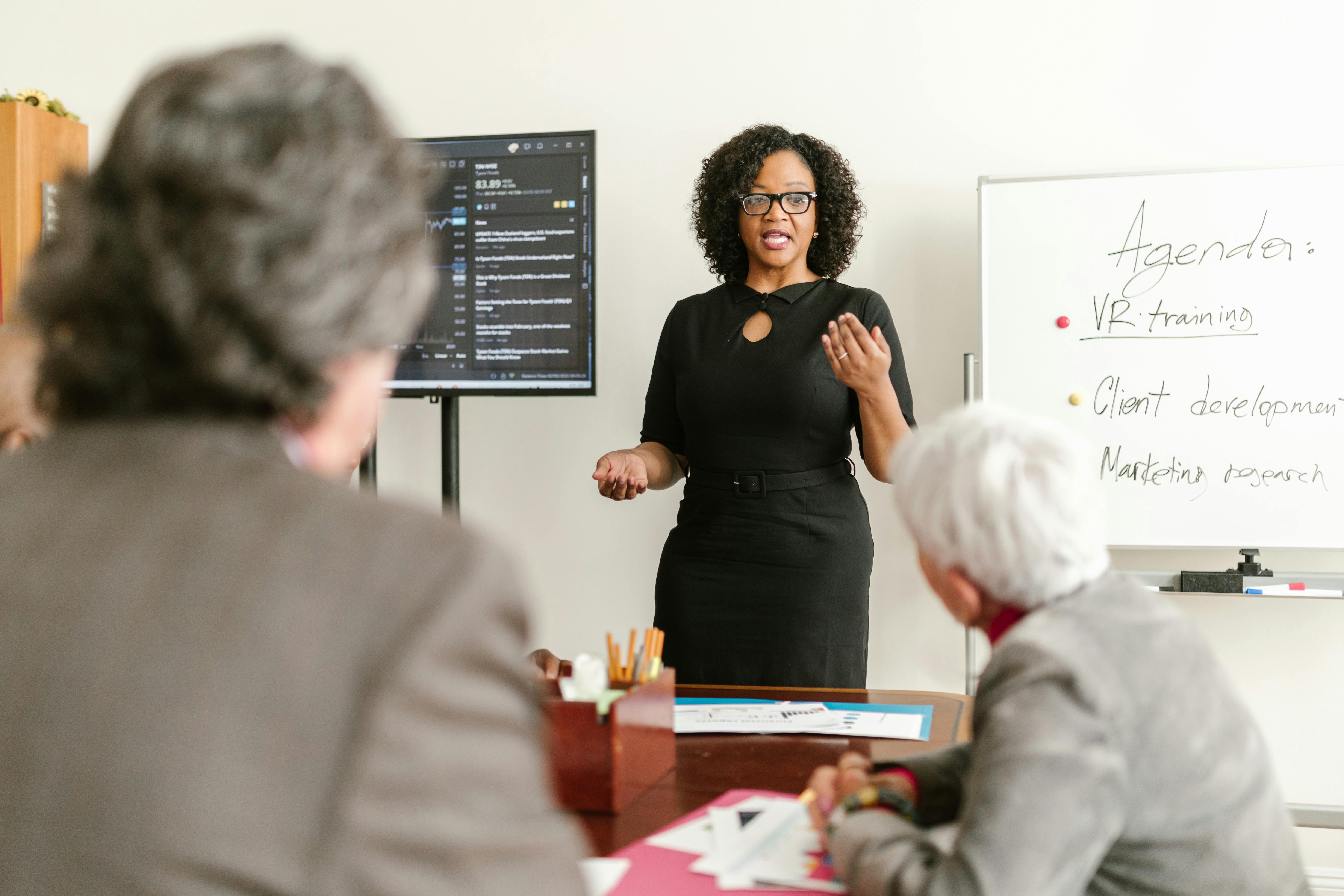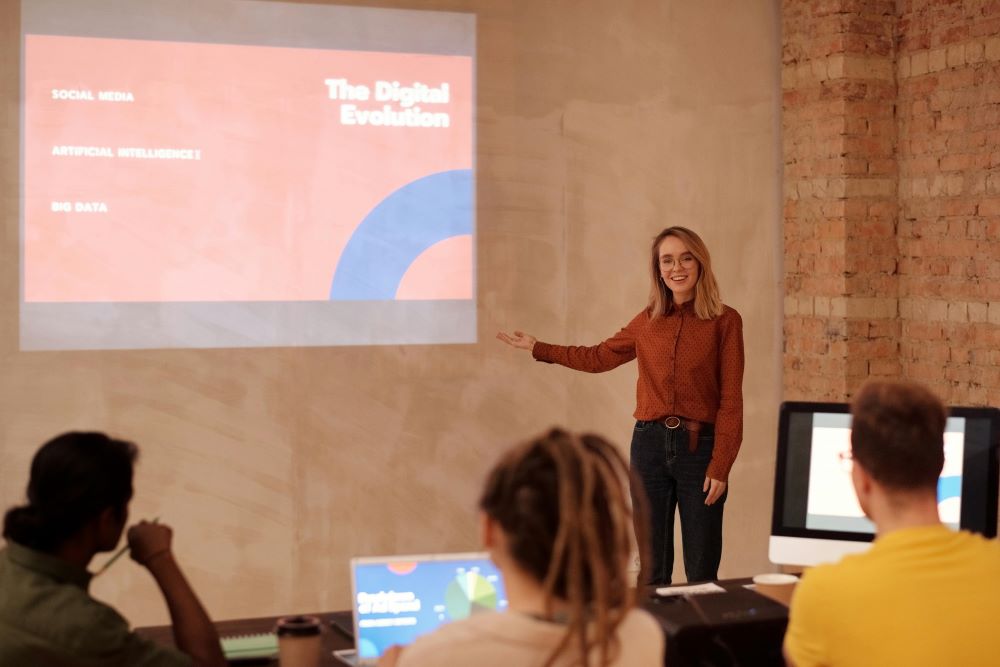Support Page Content
Communication
Listening

Listening is a critical competency, whether you are interviewing for your first job or leading a Fortune 500 company.
 Listening is a critical competency, whether you are interviewing for your first job or leading a Fortune 500 company. Surprisingly, relatively few working professionals have ever had any formal training in how to listen effectively. In this course, communications experts Tatiana Kolovou and Brenda Bailey-Hughes show how to assess your current listening skills, understand the challenges to effective listening (such as distractions!), and develop behaviors that will allow you to become a better listener—and a better colleague, mentor, and friend.
Listening is a critical competency, whether you are interviewing for your first job or leading a Fortune 500 company. Surprisingly, relatively few working professionals have ever had any formal training in how to listen effectively. In this course, communications experts Tatiana Kolovou and Brenda Bailey-Hughes show how to assess your current listening skills, understand the challenges to effective listening (such as distractions!), and develop behaviors that will allow you to become a better listener—and a better colleague, mentor, and friend.
LinkedIn Learning E-course, 1 hour
Just as public speaking is a skill that you can hone through practice, good listeners aren't in possession of a special, unattainable gift—careful listening is a skill that you can learn. In this course, join career expert Dorie Clark as she helps uncover why it's hard to listen well, and how to develop the mindset of a good listener. She also provides multiple listening strategies to help you manage when you're the one not being listened to, how to keep yourself from interrupting, and how to listen to what's not being said. In addition, she explains how to let others know that they've been heard, and how to listen with patience when you don't feel engaged with someone.
LinkedIn Learning E-course, 25 minutes
When she worked as a Senior User Research Manager at top tech companies like LinkedIn and Twitter, active listening was a huge part of Ximena Vengoechea’s job. She literally wrote the book on it! In this Knowable course inspired by Listen Like You Mean It: Reclaiming the Lost Art of True Connection, Ximena teaches you how to become a better listener and communicator. Learn how to discern between surface and empathetic listening and how to communicate more productively using listening loops. Plus, find out how to navigate the three levels of listening: what is said, what is meant, and what is felt. Together, these new skills empower you to build stronger connections at work and in life, give and receive more honest feedback, and discover what others think and feel beyond the words they say.
LinkedIn Learning Audio Podcast, 27 min
Listening is a critical skill that empowers leaders to make strong connections and an impact. In this course, Dr. Eric Zackrison explains how to be a leader who makes people feel heard by understanding others more effectively, overcoming barriers to listening, controlling emotions, being present, and becoming an active listener. When you're listening, it's important to truly understand and engage with the other person. Listening helps you reach an agreement faster and become a trusted advisor. Eric teaches how to overcome common barriers to good listening, such as confusion, miscommunication, personal biases, and emotional reactivity. He highlights how to listen directly and avoid common pitfalls to listening well. Eric also discusses how to be present when you're listening to others and how to use nonverbal cues. In conclusion, he presents several useful tips on how to actively listen.
LinkedIn Learning E-course, 49 min
Speaking

Your communication skills affect your career prospects, the value you bring to your company, and the likelihood of your promotion.
Confidence is one of the secrets of impactful communication. But how do you cultivate it effectively as you grow? In this course, join instructor and professional speaking coach Vinh Giang as he shares insights, strategies, and practical techniques on how to start communicating with more clarity, power, and confidence. Discover the foundational skills of a successful communicator, developing your power of presence along the way. Learn how to manage your message, master your voice and body language, communicate with confidence digitally, and handle nervousness and overcome your fear. Upon completing this course, you’ll be equipped with the self-awareness you need to continue building your skills and improving your communication style.
Linkedin Learning E-course, 1 hour and 13 minutes
Effective communication is a learned skill, not something that you are naturally born with. In this course, communication coach TJ Guttormsen helps you to understand the fundamentals of centered communication and equips you with practical techniques to build conversations that are more likely to yield great results professionally and privately. TJ begins with basics like how to interact with intent, make the right first impression, and analyze your own sub-communicative skills. He goes over a variety of useful conversation techniques, then concludes with practical steps you can take to practice your techniques in the real world.
LinkedIn Learning E-course, 57 minutes
Your communication skills affect your career prospects, the value you bring to your company, and the likelihood of your promotion. This course helps you communicate better in a variety of professional situations, including meetings, digital communications, pitches, and presentations. Instructors Tatiana Kolovou and Brenda Bailey-Hughes introduce the four building blocks of communication—people, message, context, and listening—and show how they apply in different circumstances. Join Tatiana and Brenda as they share their communications tool kits and show you how to build this core competency and communicate in a way that effectively and professionally conveys your message.
LinkedIn Learning E-course, 1 hour and 10 minutes
Want to ensure that your best ideas are heard by the right people in your organization? Improve your ability to speak up at work. In this course, join communications and media expert Jessica Chen as she uncovers the common mental barriers that keep professionals from speaking up at work, as well as the steps you can take to actively build your authority. Jessica discusses how your childhood, cultural, and work experiences may have shaped your perception of good communication. She goes over how to ask the right questions and effectively tailor your message to suit your audience. Plus, she shares tips for showcasing your confidence, whether you're speaking to people on video or in person.
LinkedIn Learning E-course, 22 minutes
Writing
 Writing email is a vital and often overlooked part of professional communication. When you use proven strategies for writing great messages, people enjoy working with you and are eager to cooperate on shared goals—all of which helps you get recognized and get ahead at work.
Writing email is a vital and often overlooked part of professional communication. When you use proven strategies for writing great messages, people enjoy working with you and are eager to cooperate on shared goals—all of which helps you get recognized and get ahead at work.
In this course, instructor Sam Bennett shows you how to write great emails that'll leave a positive impression. First, Sam explains that being both personal and direct contributes to a high ROI, no matter who your recipient is. She goes over how to utilize the basic types of emails: inquiry, transactional or informational, and marketing or sales. She steps you through how to write engaging yet clear emails that grab your customer's attention and keep it. Sam teaches you what makes a good story work and what will convert prospects to customers. She walks you through best practices to make sure your emails get read at the right time by the right people and how to craft a relevant call to action.
Linkedin Learning E-course, 57 minutes
Writing email is a vital and often overlooked part of professional communication. When you use proven strategies for writing great messages, people enjoy working with you and are eager to cooperate on shared goals—all of which helps you get recognized and get ahead at work. In this short course, Mignon Fogarty shows you how to transform your messages with confident writing and insights into how readers experience your emails on a human level. Discover how to write a compelling opening, how to make sure your messages get opened, how to message the right people at the right time, and more to up your game and write powerful, effective messages.
Linkedin Learning E-course, 56 minutes
Many people have a love-hate relationship with email. Studies have shown that the average businessperson spends more than a dozen hours a week writing emails. Every detail, from grammar to tone to timing, impacts your reputation and personal brand. Join Dr. Daisy Lovelace as she shares tips to strengthen your email skills and shape a positive online reputation.
LinkedIn Learning E-course, 35 minutes
Plain language is a modern communication philosophy and a worldwide movement. It’s the reader-focused way to write, ensuring every sentence is easy to read and understand. This course provides a clear definition of plain language and helps you adapt your writing to this concise, modern style. Online writing expert Leslie O’Flahavan explains how to focus your content, add structure with tables and lists, use active voice, and adopt a direct, personal style that communicates clarity and confidence to your audience. Follow along and learn how to write content that helps people understand what they’ve read and find the information they need—to get important things done.
LinkedIn Learning E-course, 42 minutes
Learn how to write formal business letters and emails that are short, clear, and to the point. This course teaches you how to get results and build better relationships with clients, colleagues, and customers. Writer and journalist Tom Geller helps you clarify your goals, research your topic and intended audience, and structure your correspondence. Plus, get tips about writing for accessibility—making your writing comprehensible, concise, and appropriate for all readers—and following up on communication.
E-course, 36 minutes
Most professionals can't afford full-time proofreaders. With some simple tips and extra attention to detail, you can edit your own writing and make sure it's as polished as possible before you hit send. Learn the five keys to effective editing, from checking content, spelling, and grammar to applying basic formatting. Find out how to apply these rules to emails, presentations, and blog posts—yours or someone else's—and create style guides and templates to be more productive. Instructor Erin Rickard, a writer, professor, and long-time editor, also points out the most frequent mistakes writers make and provides tips for finding and correcting them.
E-course, 39 minutes
Nonverbal Communication
 Communication is not just about what you say, but how you say it. The subtleties of body language, facial expressions, and even your entrance into a room can speak volumes.
Communication is not just about what you say, but how you say it. The subtleties of body language, facial expressions, and even your entrance into a room can speak volumes.
People communicate constantly using nonverbal gestures, posture, movement, and facial expressions, but most people focus only on words. Join behavioral expert and author Vanessa Van Edwards as she shares how to spot and interpret nonverbal cues from others and how to take control of your own nonverbal communication. Vanessa also discusses how to read hidden emotions, how to show others you are engaged, and how to leverage your nonverbal communication.
LinkedIn Learning E-course, 27 minutes
Communication is not just about what you say, but how you say it. The subtleties of body language, facial expressions, and even your entrance into a room can speak volumes. In today’s digital age, where virtual meetings have become a norm, understanding and adapting these non-verbal cues is more crucial than ever. In this course from genConnectU, Emmy Award-winning journalist and coach Jane Hanson guides you through the nuances of these silent yet powerful forms of communication.
LinkedIn Learning E-course, 25 minutes
Start E-course: Mastering Non-verbal Communications with Confidence
It's essential to master the skills of body language in the workplace. These skills provide you with tactics that can help display confidence and empathy, as well as build rapport and increase your presence as a leader. They also offer valuable models to enhance the way you use and respond to first impressions, gestures, tone, voice, and more. In this course, gather insights on the best practices for using body language in the physical workplace, with tips to accommodate virtual meeting spaces as well. Join nationally recognized professor of communication Dr. Dustin York as he shares his knowledge and a few easy-to-follow models that you can engage and implement immediately on your own. By the end of this course, you’ll have a new set of workplace body language skills that you can apply to help you succeed in your career.
LinkedIn Learning E-course, 51 minutes
Start E-course: Body Language Essentials for the Working Professional
Interpersonal Communication
 Learn how to understand others’ perspectives, balance empathy and accountability, demonstrate listening, and respond appropriately to a variety of verbal and nonverbal cues.
Learn how to understand others’ perspectives, balance empathy and accountability, demonstrate listening, and respond appropriately to a variety of verbal and nonverbal cues.
Communicating effectively isn't an innate talent that some people have and others don't—it's something that anyone can learn and practice. In this course, learn strategies that can help you hone and master your interpersonal communication skills. Join personal branding and career expert Dorie Clark as she shares techniques for getting your message across effectively in the workplace, and explains how to tackle potential communication challenges with your colleagues and supervisor. She also discusses how to grapple with tricky situations, taking you through how to handle interruptions, and respond to critical feedback.
LinkedIn Learning E-course, 42 minutes
Developing your emotional intelligence can help you succeed at any stage of your life or career. It can also help you become a better leader, mentor, and coach. In this course, Brenda Bailey-Hughes defines exactly what emotional intelligence is and how it can help you manage your emotions and build stronger relationships. Learn how to understand others’ perspectives, balance empathy and accountability, demonstrate listening, and respond appropriately to a variety of verbal and nonverbal cues. Using these simple techniques, you can quickly improve your communication and make conversations at work and home more productive and satisfying.
LinkedIn Learning E-course, 43 minutes
No one wants to go through life misunderstood. If you are worried you have a reputation for being unapproachable, there are ways to change that perception without changing your personality. In this course, personal branding expert Dorie Clark helps you first determine whether you are sending signals that might be off-putting to others—whether through body language or some other kind of communication. She outlines strategies to make yourself more approachable both in person and E-course, by helping others feel included. With the right mindset, and the right messaging, you can help people see the real you.
LinkedIn Learning E-course, 28 minutes
Introverts face some unique challenges when it comes to communication and socializing. In this course, communication coach TJ Guttormsen offers insights and practical strategies designed to help introverts develop the ability to communicate with confidence in any situation of their personal or professional lives. Learn how to overcome social fears and worries, build confidence from within, and recharge and maximize your energy for social life. TJ shows you what it takes to project confidence through voice, tone, and body language and become more comfortable speaking, regardless of what’s at stake. By the end of this course, you’ll be prepared to speak up in groups, address common challenges such as interruption, and start and sustain meaningful conversations with just about anyone.
LinkedIn Learning E-course, 1 hour and 16 minutes
In this course, communication professor Melanie Whitney teaches the foundations of mindful communication in order to speak with greater emotional intelligence, self-awareness, and conflict competence. She first helps you identify ways that your ego impacts your communication and ways to spot and lessen your reactivity while communicating. She then outlines techniques to deepen self-awareness while communicating by recognizing the ways you communicate with yourself, and shares simple mindfulness strategies to stay present during communication with others. Finally, she shows you how to navigate even the most challenging conversations through mindful listening and shares strategies to communicate in ways that invite connection and alignment.
LinkedIn Learning E-course, 43 minutes
Start E-Course: Mindful Communication for Less Conflict and Stronger Relationships
Presentations
 Learn practical tips for exuding presence and poise when speaking to audiences large and small.
Learn practical tips for exuding presence and poise when speaking to audiences large and small.
The ability to deliver a powerhouse presentation isn't reserved for a gifted few. With enough practice, anyone can learn how to express themselves with confidence. In this course, join communication coach Jackie Miller as she shares practical tips for exuding executive presence and poise when speaking to audiences large and small. Explore different communication styles (and how to embrace your own). Get theater-based techniques for improving eye contact and harnessing the power of breath. Plus, learn best practices for amplifying voices that may otherwise go unheard; ridding your speech of qualifiers, fillers, and apologies; communicating effectively when English isn’t your first language; and more.
LinkedIn Learning E-course, 37 minutes
Start E-course: Improve Presentations and Executive Presence
Develop the skills you need to prepare and deliver an outstanding speech or presentation. In this course, Laura Bergells offers practical insights that can help presenters prepare, open, deliver, and close their speeches. Along the way, discover how to project confidence, outline a speech, take questions, and develop the creative story that adds life to a speech.
LinkedIn Learning E-course, 1 hour
Delivering an expert presentation doesn’t have to be nerve-wracking or complicated. Join Duke University professor Dr. Daisy Lovelace as she shares quick and practical tips on how to speak confidently in front of a group. Learn how to own the presentation space, use gestures, moderate your voice, and connect with your audience.
LinkedIn Learning E-course, 31 minutes
Join master presenter Todd Dewett as he outlines the basic elements of delivering a great presentation and staying on message. Todd discusses the "pre-work" involved in a great presentation so that you feel—and are—well prepared. He also delivers tips on creating handouts and slides that contain just the right amount of information, responding to your audience, and recovering from the occasional mistake.
LinkedIn E-course, 19 minutes
Master virtual presenting with Diane DiResta, a seasoned communication strategist. This course equips you with skills to maintain audience engagement and build trust in digital settings. Learn message preparation, audience engagement techniques, and managing group dynamics in virtual meetings to overcome distractions and limited control.
LinkedIn Learning E-course, 45 minutes